Saint Louis Country Club
MO, USA
Green Keeper: Tim Burch
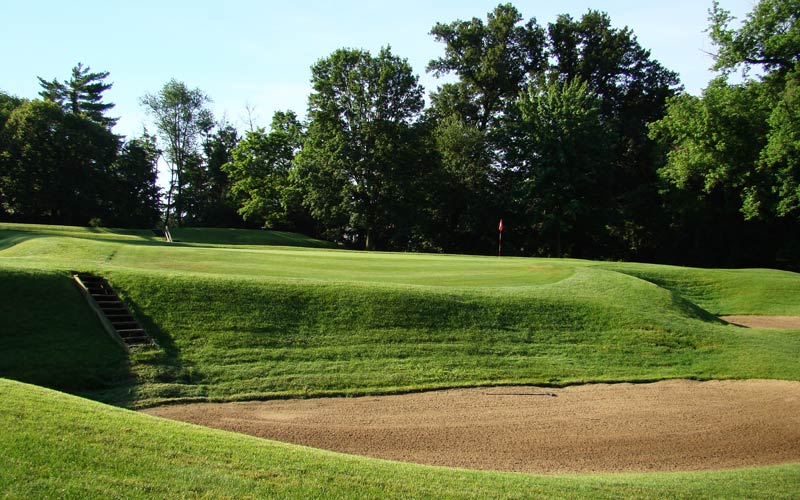
Saint Louis Country Club is rich with classic Charles Blair Macdonald features. As seen at the Eden above, Macdonald’s one reservation about the original one at St. Andrews was that the golfer could use his putter to play the entire hole. He got rid of that option here (!) with the deep Hill bunker walling off direct access to the putting surface.
From the time that Charles Blair Macdonald hired Seth Raynor in 1907 as an engineer to oversee the construction of National Golf Links of America, the two men formed a lasting relationship born out of respect for one another’s talents. Macdonald’s sense of grandness and flair added artistry to Raynor’s skills as an engineer and they did better work together than separate.
Apart from the overall excellence of their designs, MacDonald and Raynor enjoy an almost cult standing for another reason: they often replicated strategic concepts from famous holes. To this day, the traveling golfer takes great delight in seeing how MacDonald and Raynor adapted such concepts from site to site. As much as anyone, Macdonald helped Americans gain a sense of just how engaging golf could be by letting them appreciate first hand many of golf architecture’s most enduring dilemmas such as the Redan or Alps. His strong sense of strategic purpose gave American golf architecture a huge push in the right direction during its infancy and helped it move quickly past the basic courses that the Scots built in this country pre-1905.
In the case of Saint Louis Golf Country Club, Macdonald (as architect) and Raynor (as construction supervisor) were blessed with ideally rolling terrain. From this promising start, they gave Saint Louis Golf Country Club more than its fair share of the great versions of holes plus several original ones that are equally vexing in their own right. In fact, apart from Macdonald’s masterpiece National Golf Links of America, Saint Louis Golf Country Club as as many of Macdonald’s favorite features as any of his designs.
One man with a long appreciation of Macdonald and Raynor is Saint Louis Golf Country Club’s former Green Keeper Jack Litvay. From when he saw his first Raynor course in Minnesota in 1959 (!) to when he realized similarities with its architecture and that at the Dunes Course at Monterey Peninsula Country Club in the late 1960s, Macdonald and Raynor fascinated Litvay. When the green keeping opportunity presented itself at Saint Louis Golf Country Club in 1977, he jumped at it and stayed there until he retired in 2005. During that period, he was instrumental in relocating the Punchbowl green to its original, charming location. More importantly, he helped raise awareness as to the special architectural gem that the club possessed. In 2000, the club approached Brian Silva for a Master Plan. Silva, who was just coming off a highly successful restoration at Raynor’s Lookout Mountain in Georgia, was just the man to help guide the club in restoring all the fun, one-of-a-kind shots that Saint Louis possesses in spades as we see below.
Holes to Note
Second hole, 220 yards, Double Plateau; Saint Louis Golf Country Club possesses only three two shotters longer than 410 yards. However, its par of 71 to cover the 6,535 yards is anything but easy, thanks in large part to its difficult set of five one shot holes. The second is a bear of an uphill Biarritz, which isn’t ideal only in the sense that the golfer can’t witness his ball disappear in the swale in the green before re-appearing on the back plateau. Nonetheless, this one shotter gives the course the kind of muscle that saw 282 as the winning score in the 1947 United States Open.
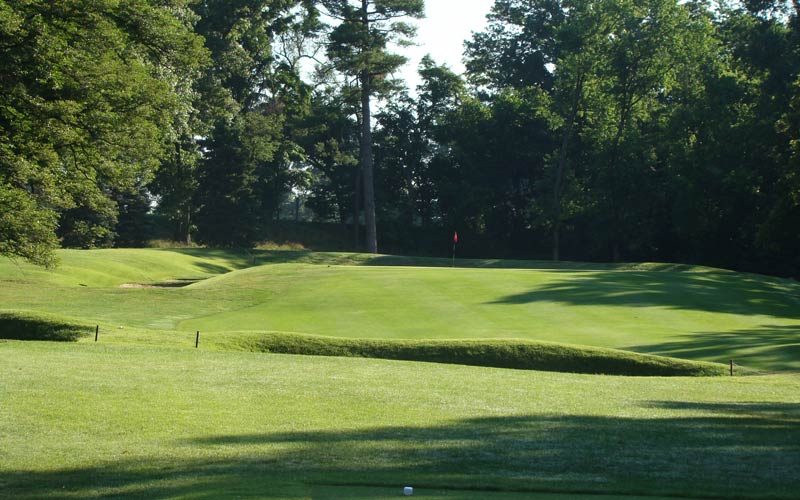
As the second plays uphill, the three foot swale…
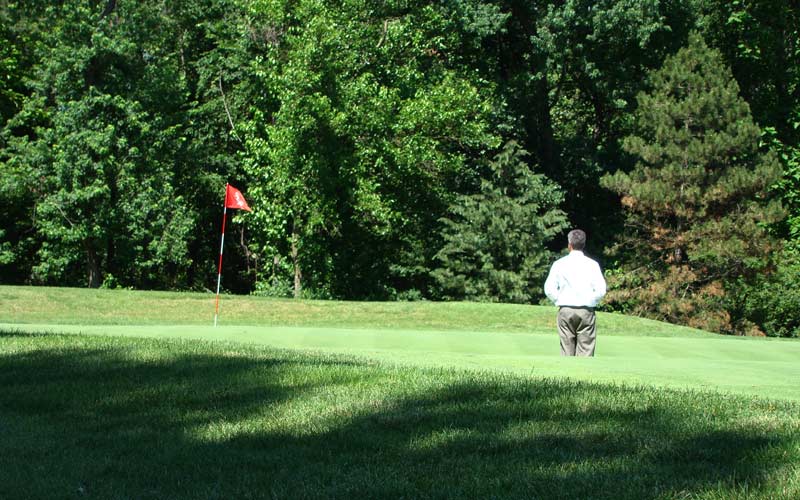
… that runs through the middle of the green isn’t visible from the tee. As is frequently the case, the green for this Biarritz is the largest one on the course, measuring over 11,000 square feet.
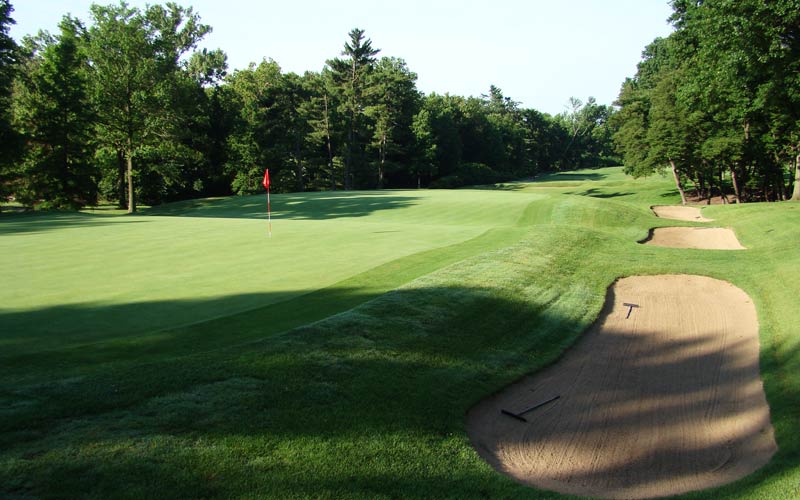
As seen from back left of the green, this Biarritz green measures 55 yards in length. The swale in the green is evident; less evident is the ten foot deep bunker front right of this green complex.
Third hole, 210 yards, Eden; An unusually long Eden hole, the third was selected as one of the greatest holes in George Peper’s The 500 World’s Greatest Golf Holes. Almost all the key Eden features are present: deep bunkers cut into a ridge that the green sits upon, a false front, a green featuring a sharp back to front tilt, and death over the green. The only attribute missing is that the green isn’t a skyline one, a quality that is harder to achieve in the middle of this country than it is along the coastline in Scotland.
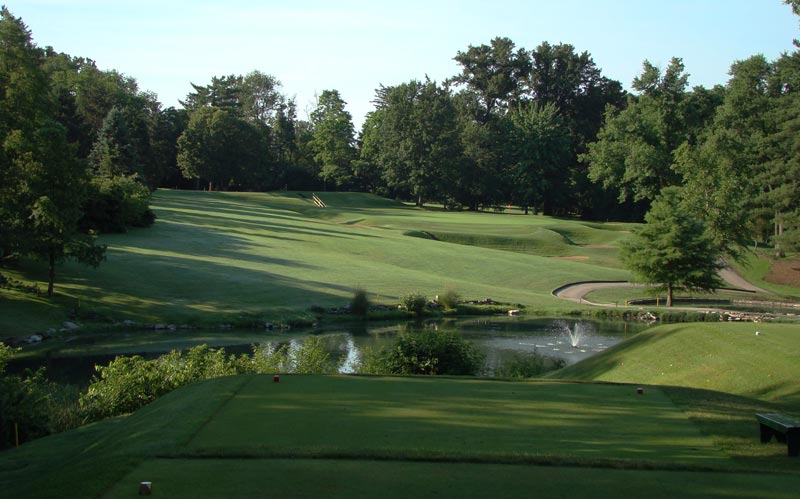
If this Eden green complex seems a long way away, it’s because it is! At over 200 yards, this Eden is approximately forty-five yards longer than when the course first opened. Of course, in Macdonald’s day of hickory shafted clubs, this 165 yard hole required a mashie which is the same club (a.k.a. a five iron) that top amateurs hit into this green from today’s 210 yard markers.

As seen from behind the green, any tee ball that goes long leaves a desperately difficult recovery from the four foot deep back bunkers to a green sloping sharply away and toward the front.
Fourth hole, 410 yards, St. Andrews; As part of Silva’s Master Plan which was adopted in 2005, the Road Bunker was recently restored to its right central, gathering location along this green, which angles from front left to back right. Equally noteworthy though is the diagonal valley that runs through the fairway: if the golfer can carry it long down the left, he is rewarded with a level stance and a perfect angle into the green. Otherwise, the twenty yard wide valley has a way of gobbling up tee balls, thus making the approach shot blind to semi-blind.
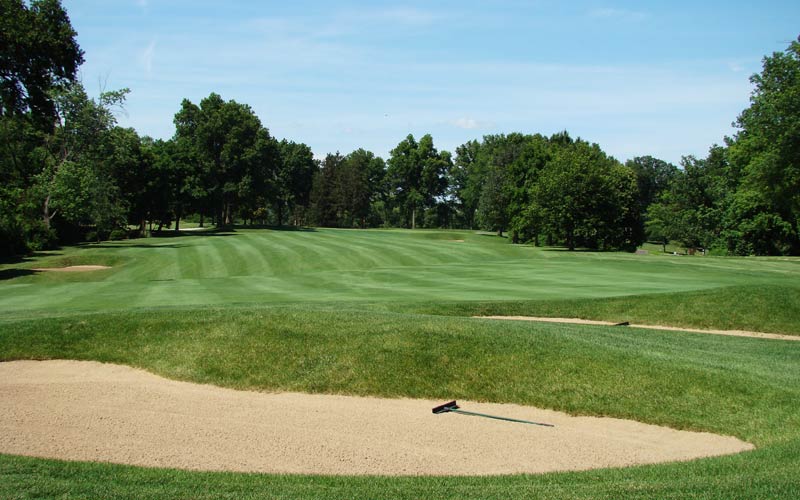
Adhering to Macdonald’s original drawing, short cross bunkers have been restored on three of the first four holes, including here at the fourth as seen above. In fact, twenty-seven bunkers have been restored per Silva’s Master Plan, many of them being of the central or cross hazard type. Note the valley that Macdonald put to brilliant use further ahead in the fairway.
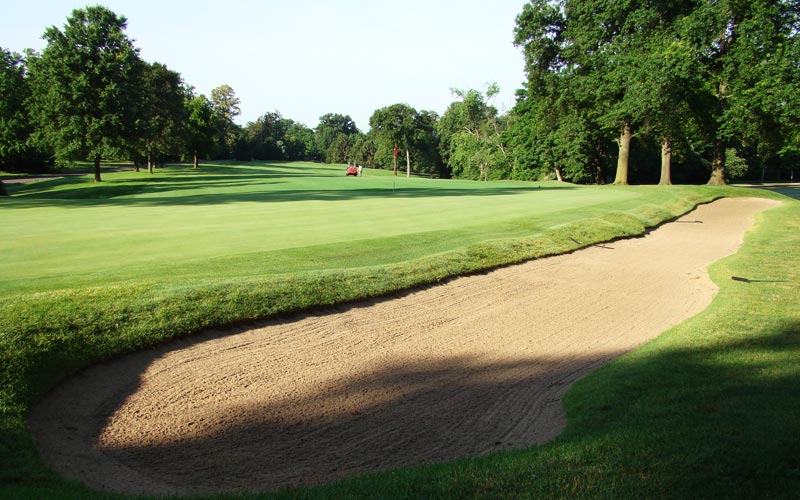
This long back bunker replicates the road behind the seventeenth at The Old Course at St. Andrews.
Fifth hole, 510 yards, Punch Bowl; Macdonald and Raynor frequently combined an Alps approach with a Punchbowl green with spectacular examples being the fifteenth at Sleepy Hollow and the fourth at Fishers Island. Such is the case here, though uniquely, this time the hole is a three shotter. Also, another of their favorite features was brought into play, a Principal’s Nose bunker 140 yards shy of the green which influences the layup shot. Shockingly enough, this Punchbowl green was relocated in the 1950s to the far hillside in the misguided interest of ‘fairness’. Thankfully, Silva over saw the return to its original spot in 2001 with the cinders underneath the ground acting as a helpful guide in recreating the size and slopes of the original green. Once again, golfers going for the green in two take great delight in trying to land their approach shot just past the crest of the hill on the right and have it chase down onto the putting surface. The thrill of making the 200 yard plus walk wondering just how close your ball might be to a hidden hole location is – sadly – rarely found in inland golf.
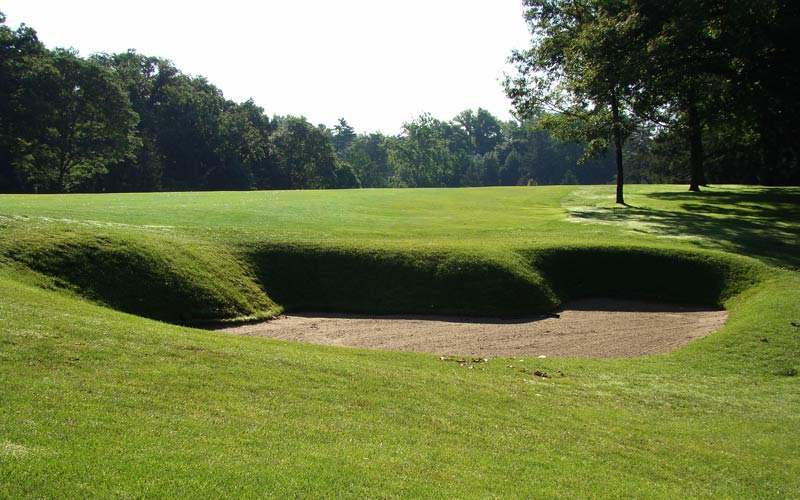
Straight from tee to green, the fifth gains its playing interest thanks in part to its fascinating array of bunkers. This one is cut into the hillside 240 yards from the back markers and was recently edged more into the fairway.
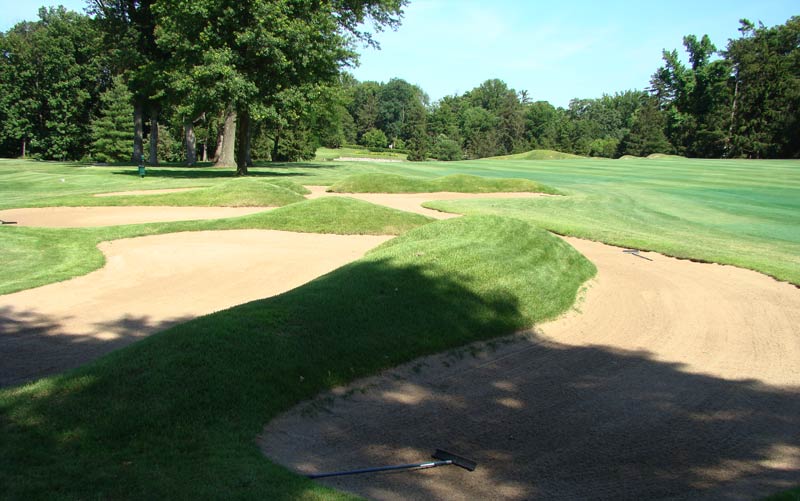
On the left of the fairway, these fifty yard long ‘snake’ bunkers need to be avoided.
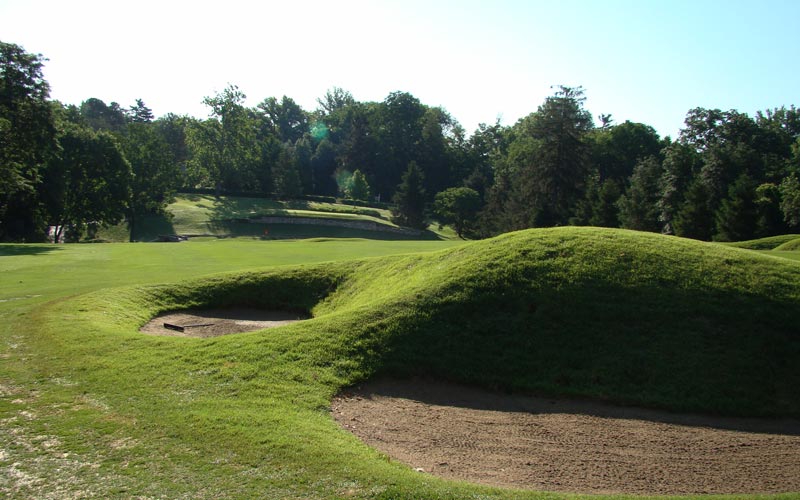
Most famously, this Principal Nose bunker complex 140 yards from the green dominates play down the middle of the hole. It was restored to its original Macdonald location by Green Keeper Tim Burch who uncovered clay tiles and sand in this area after studying an old photo of the Crater hole that showed this bunker complex in the background.
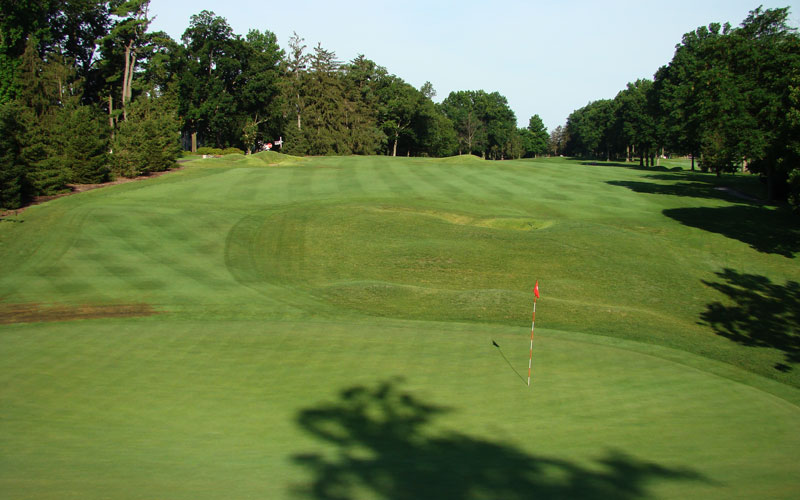
Looking back down the fifth from behind, one sees the Punchbowl green and the right portion of the fairway that feeds onto it.
Sixth hole, 360 yards, Blind; An original drive and pitch hole of great merit, thanks to the site’s rolling topography and its wild green contours. In 1915, the year after Saint Louis Golf Country Club opened, Raynor began designing courses on his own but by and large, his solo greens never achieved the same boldness of character as when Macdonald was present. The sixth green complex illustrates how well the two men worked together and makes one lament the fact that they only did twelve eighteen-hole courses together.
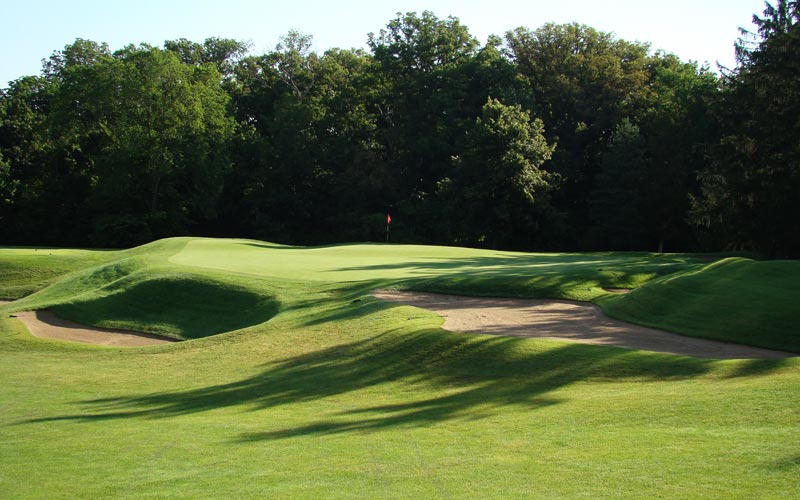
One of the game’s great green complexes is the sixth at Saint Louis. Better to use the bold green contours as a backboard than to come up short on one’s approach.
Seventh hole, 155 yards, Shorty; A superb Short Hole with its thumbprint or horseshoe green contours helping to make it more engaging than either the fourth at Brancaster or the eighth at St. Andrews from which the name ‘Short’ derives.

The built-up green complex makes it one of the most fortified Short Holes in the game, though at 7,800 square feet in size, the green is more than a reasonable target.
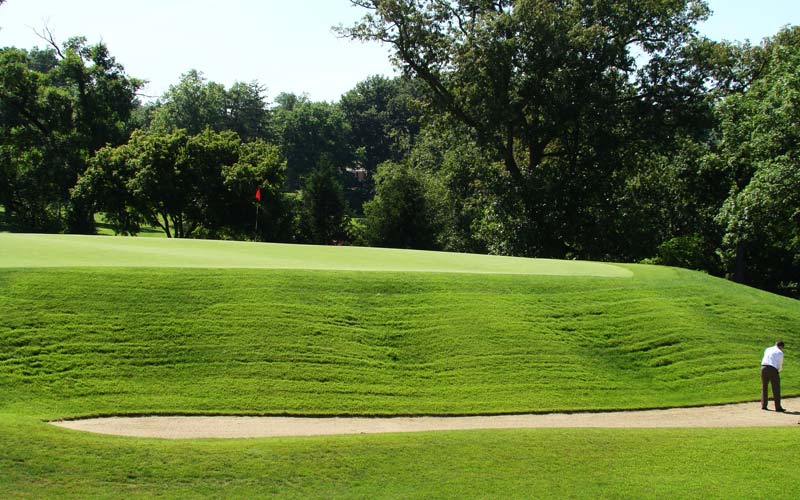
The true challenge of the hole is best appreciated when one considers that when the course opened for play in 1914, golfers only had a niblick (or nine iron) as the sand iron had yet to be invented. The seventh green was truly a hit-it-or-else proposition as recovery from the nine foot deep front bunker was quite difficult.
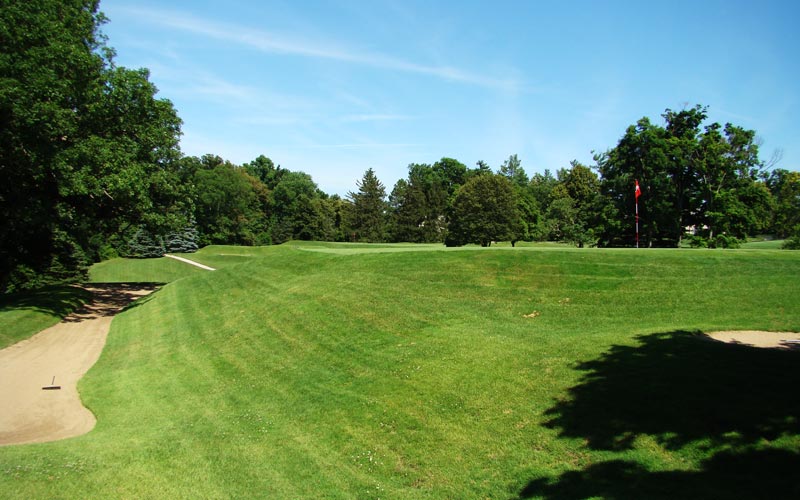
As seen from behind, a shot over or a miss right of the green offers no solace either.
Eighth hole, 350 yards, Cape; This is a true Cape hole, which is a rarity, in that not only does the fairway swing around a hazard but the green itself protrudes into the same hazard. For those that shy away from the hazard on the right with their tee ball, the recently restored Macdonald bunker complex that protrudes fifteen yards into the fairway from the left side of the green has made the approach shot more complicated/deceiving. The in-the-dirt work by Kye Goalby in restoring the bunker complex according to Silva’s Master Plan is excellent.

An intelligent tree clearing program has opened up some of the beautiful interior features of Saint Louis Country Club. Just a few years ago, the stream upon which the dogleg right eighth swings around was largely hidden from view.
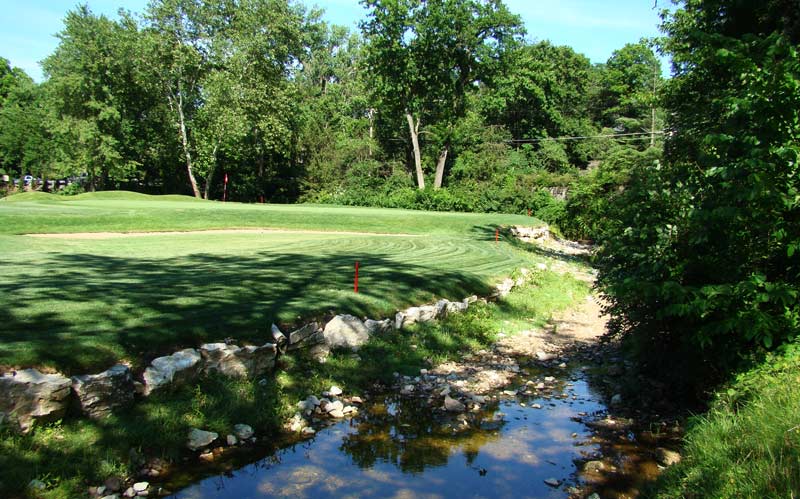
The creek’s presence is strongly felt at greenside, where it hugs the right and back side.
Ninth hole, 510 yards; Some students of golf course architecture contend that courses built in the 1910s tend to have both a relative high number of straight holes and a relative absence of doglegs. Such is indeed the case at Saint Louis Country Club with its one true dogleg being the prior hole, the Cape. Of course, the rectangular nature of the club’s property had a lot to do with the creation of a number of fairly straight playing corridors. Having said that, Macdonald excelled in how he routed the holes upon the rolling ground and incorporated features that influenced play down the middle of the holes. The ninth is a prime example of a straight playing corridor that nonetheless has a lot of character from tee to green. Ideally, and especially true back in the days prior to fairway irrigation, the golfer hit a hot hook that chased off the pronounced right to left fairway slope and ended up with a level lie on the left edge of the fairway down near the creek. The additional run off the sloping fairway brought the green in reach in two and from there, the golfer had the perfect angle into an open green.
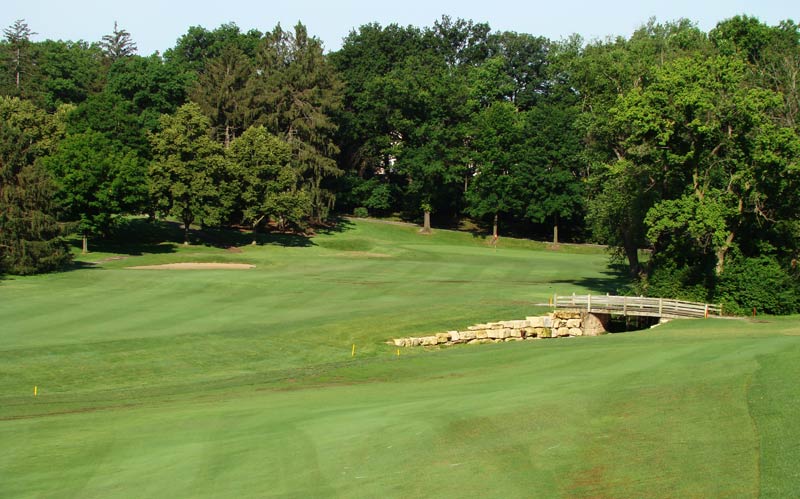
As seen from the high right side of the ninth fairway, the same stream that dominates play at the eighth was also put to great use at the ninth. A lesser architect might have used it as a fronting hazard but Macdonald’s use of it on a diagonal has confounded second shots for decades.
Eleventh hole, 405 yards, Valley; The tenth and eleventh parallel each other and play across the same broad valley. The tenth hole’s primary defense is its fiercely sloping back to front green whereas here at the eleventh, one of the course’s most noteworthy bunkers hides the putting surface.
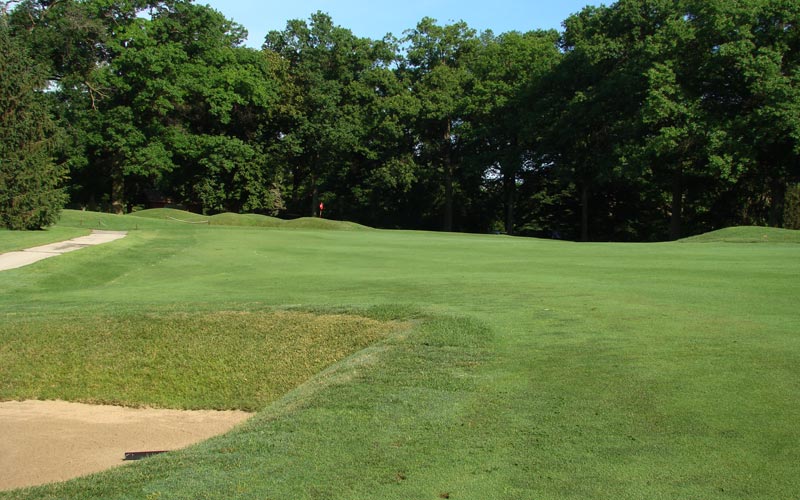
Even more impressive than this deep fairway bunker upon which the eleventh fairway bends left around is the greenside bunker seen in the distance. Its pronounced humps and bumps make it appear as if it was pulled straight from National Golf Links of America.
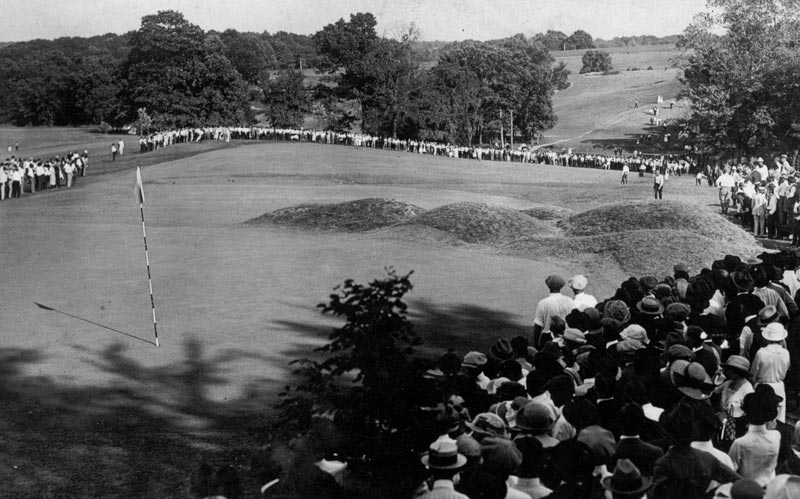
This view from behind the eleventh green in 1921 captures the dramatic nature of the mounds at the left front of the green. It’s their very boldness that Goalby so successfully recaptured.
Twelfth hole, 180 yards, Crater; While Saint Louis Country Club possesses the four essential Macdonald/Raynor one shotters (a Short, Eden, Redan and Biarritz), it has a unique fifth one as well. The hole enjoys natural properties inherent upon playing across a valley but what makes it famous is a series of mounds that ring the back of the green, exuding a charm all their own. At 4,500 square feet, the green is the smallest target on the course.
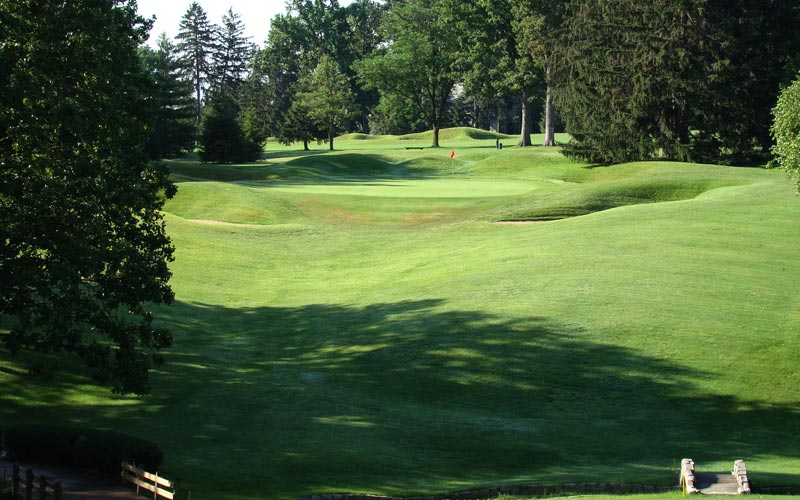
The view from the twelfth tee, named the Crater hole. Note in the distance how the mounds of the Principal’s Nose bunkers in the fifth fairway seem to compliment the mounds around this green. It was this view in an old black and white photograph that allowed the club to determine the original location of the Principal’s Nose bunker.

The fingers in the bunkers have been recently restored courtesy of Silva and Goalby. A low aerial from 1941 helped these men recreate Macdonald’s fingers, which make the bunker play as a true hazard thanks to the awkward stances they create.
Thirteenth hole, 600 yards, Clubhouse; One of Macdonald/Raynor’s very best Long holes, thanks to their superb skill in routing the hole across the rolling land. Death awaits the golfer who goes right off the tee as the ground falls sharply away. Further ahead, a diagonal series of fairway bunkers replicate the strategic benefit of carrying Hell’s Bunker at the fourteenth on the Old Course at St. Andrews. The finally hurdle is the green’s false front, which sends many a ball well back into the fairway.
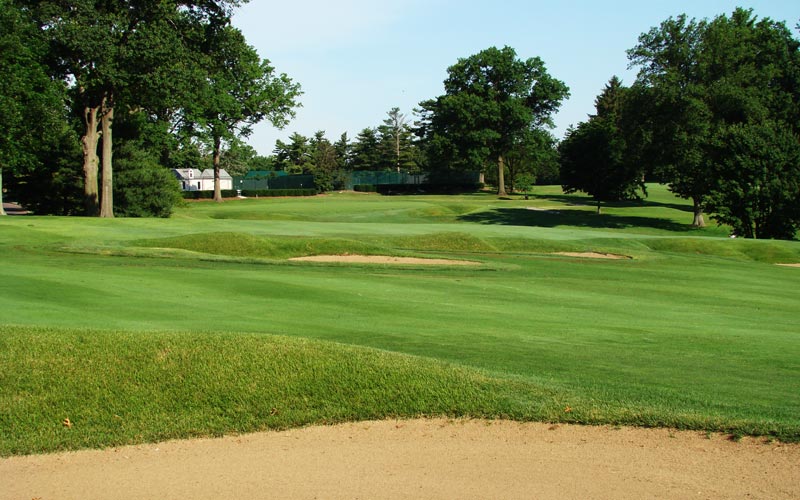
This restored bunker complex slashes diagonally across the thirteenth fairway and getting past them in two is problematic if one’s tee ball doesn’t find the fairway.
Fourteenth hole, 415 yards, Dome; The longest two shotter at Saint Louis Country Club plays to a first rate reverse redan green. As part of the recent restoration work, several yards of putting green were recaptured at the front left. Golfers back in the fairway are afforded the pleasure of watching the drama slowly unfold with their approach shot as it takes the front slope and slowly feeds toward the back right of the green.

The fourteenth green is open in front and falls toward its back right. The gentleman in white is in the deep back left bunker that gathers the over-aggressive approach.
Fifteenth hole, 495 yards, Narrows; Diagonal cross bunkers divide the fifteenth fairway at the 330 yard mark from the tee. Regardless, given today’s technology, many a good player will give the green a go in two but there are an extraordinary amount of recovery shots that he may have to execute to secure his birdie, thanks to a superb Double Plateau green guarded by four bunkers. Despite the green being over 10,000 square feet, Silva points out that it screams for ‘the ball to be put on the ground! What could be a better example of this than the fifteenth green – hell, the fourteenth is another Redan so it’s good from that regard as well – but it is fifteen that really is awesome. Airborne golf doesn’t work nearly as well, especially to the back shelf locations.’
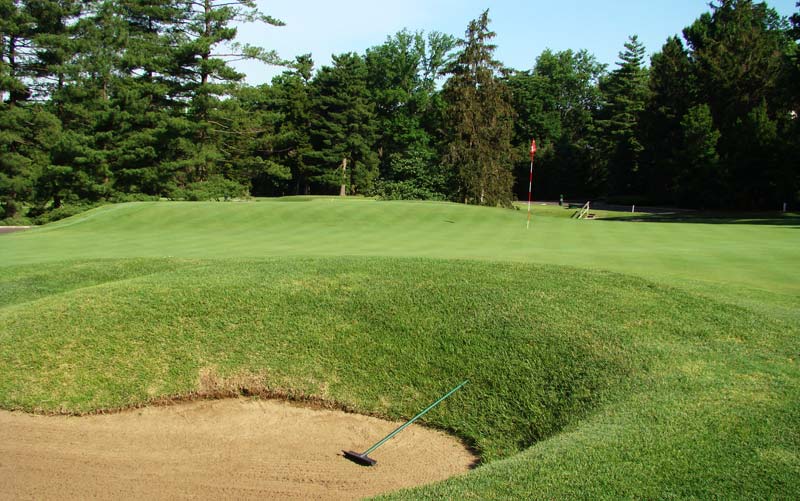
Many a three wood approach ends up in one of the four greenside bunkers. The resulting recovery shots are made all the more difficult by the out of bounds that is directly behind the back level of the Double Plateau green. Similar to the sixth at Piping Rock, when the hole is placed on the tiny back shelf, the hole plays nearly one stroke harder in competition.
Sixteenth hole, 185 yards, Redan; The Redan one shotter here is a mirror one, meaning that its green tilts from high front left to a low back right corner. In general, this hole plays well but the rub with a mirror Redan is that the ball doesn’t release quite as well from a fade as it does with a draw to a Redan. Thus, in theory, the slope of a mirror Redan needs to be even more pronounced than on a Redan and Saint Louis is presently mulling over if a slight increase in the green’s slope would make this hole play even better/more fun.
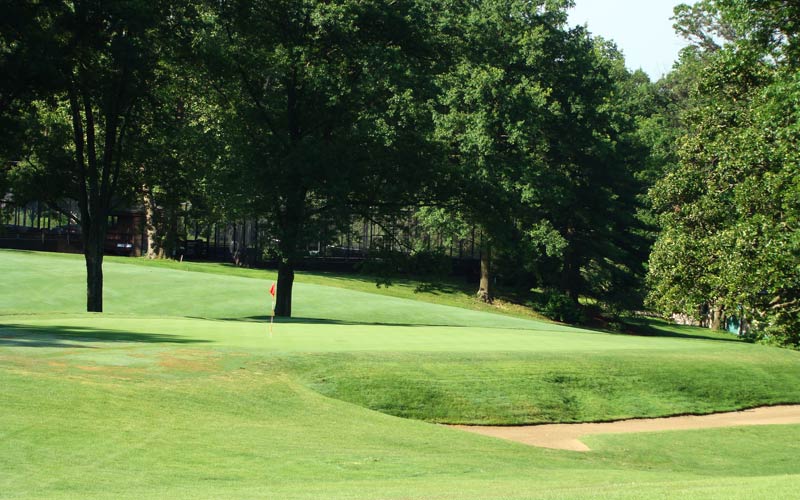
Once Macdonald determined this was the site for the Redan, the natural left to right slope dictated a mirror Redan be built. Otherwise, a Redan sloping from high right to lower left would have fought the land, something a Macdonald hole never did.
Seventeenth hole, 380 yards, Log Cabin; Based on its name, there is no reason to suspect that today’s hole is patterned after any hole in particular. Nonetheless, in the 1921 United States Amateur, this hole was deemed the ‘pride of the club,’ quite a statement based on all its other classic holes!
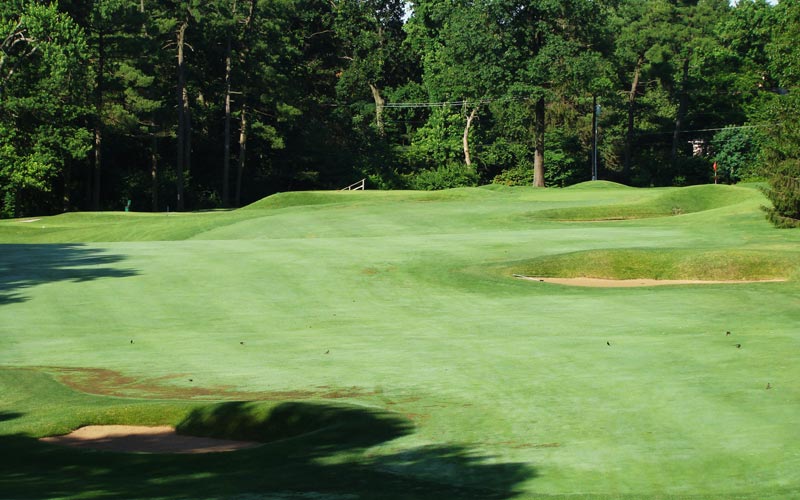
The dramatic five foot deep (as well as narrow) bunker that guards the right of the distant seventeenth green dictates the strategy off the tee is to the left. Otherwise, the golfer is left with an awkward pitch over the bunker to a shallow green.
Eighteenth hole, 410 yards, Oasis; Capturing both the charm and allure of a game here, from yet another sloping lie in the fairway, the golfer is asked to control his approach to another wonderfully conceived green complex. The nine foot deep fronting hazard at the green is an unmistakable sign that Saint Louis was always intended to test the best.
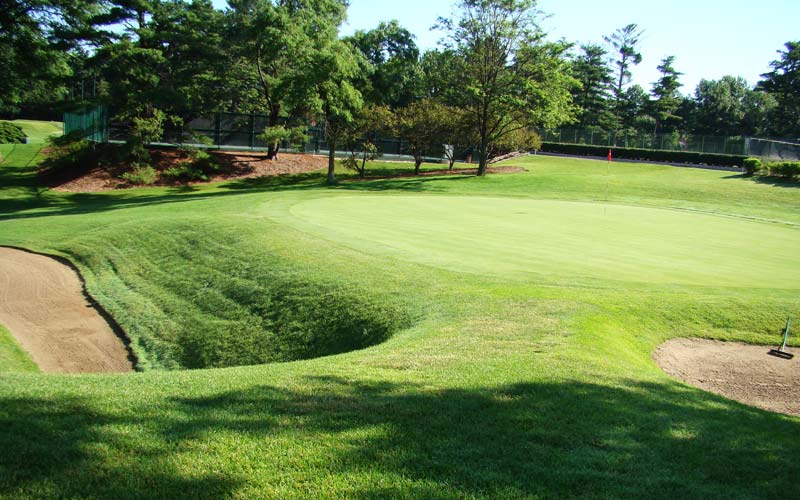
This Alps hole requires great ball striking to the very end to avoid the cavernous pit guarding the green, which in turn is sunk in its own little dell.
According to Silva, ‘Saint Louis is another example of the old timers getting two major components correct. First, they got the structure of the course correct when they brilliantly and comfortably routed the course over some up and down land. Then, they got the details correct with their collection of classic golf holes.’
Saint Louis Country Club is located in the tony suburb of Ladue, and the chances of it acquiring additional land to extend several tees is negligible. However, within its current 6,530 yards, there are many more enduring architectural features than on the 7,300 yard monsters that are presently being built. Though it will never host another United States Open, it possesses far more charm and holes of enduring character than any of the modern, longer courses in the Show Me state. From an historical perspective, it is hard to overestimate the importance of having such a cornerstone course built here in the Midwest pre-World War I. Not only did it highlight to this part of the country what a great game golf could be, it set a high architectural standard that remains worthy of emulation to this very day.
The End





![The Park, West Palm (Lit 9) [2023]](https://golfclubatlas.com/wp-content/uploads/2024/12/IMG_7092-2-scaled-500x383.jpg)


